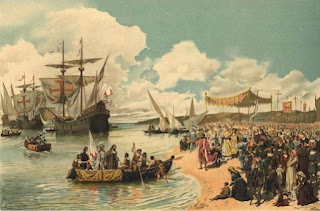The discovery of India by Vasco da Gama in 1498 is one of the most significant events in world history. It marked the beginning of a new era of global trade and exploration, and it had a profound impact on the course of Indian history.
Introduction
The exploration of new lands and distant territories has been a defining aspect of human history. The Age of Exploration, which spanned from the 15th to the 17th century, witnessed a surge of maritime expeditions driven by the desire to find new trade routes, expand empires, and satisfy curiosity about the world beyond known boundaries.
Among the renowned explorers of this era, Vasco da Gama stands tall for his pivotal role in the discovery of India, a milestone that would significantly alter the course of history. In this article, we delve into the life and journey of Vasco da Gama, highlighting his remarkable voyage that opened the doors to India for Europe.
Vasco da Gama: The Early Years
Vasco da Gama was born around 1460 in the coastal town of Sines, Portugal, to a noble family with a legacy of maritime and military service. From an early age, he demonstrated an innate curiosity about the sea and its possibilities. His interest in exploration and navigation led him to sail alongside his father, Estêvão da Gama, who was a renowned navigator and served as a Knight in the Order of Santiago.
The Search for a New Route to India
In the late 15th century, European traders sought lucrative access to the spices and riches of the East, predominantly India, but the overland routes through the Middle East were long, treacherous, and expensive. Controlling these routes were the powerful Ottoman Empire, who imposed high taxes, making the prices of spices astronomical for European merchants.
In this context, Portugal emerged as a pioneering nation in the Age of Exploration, driven by a desire to find a direct maritime route to India. Prince Henry the Navigator played a significant role in encouraging voyages of discovery and supporting scientific advancements in navigation, cartography, and shipbuilding.
Vasco da Gama's Voyage
In 1497, at the age of 27, Vasco da Gama embarked on his historic expedition, commanding a fleet of four ships - the São Gabriel, São Rafael, Berrio, and a storage ship. His journey aimed to navigate around Africa's southern tip, which was previously uncharted by Europeans, to reach the shores of India.
The expedition was not without its challenges. As they sailed down the west coast of Africa, they faced treacherous storms, navigational difficulties, and the threat of disease. Nevertheless, Vasco da Gama's exceptional leadership and navigational skills ensured that his crew stayed resolute.
After months of enduring the vastness of the Atlantic and the perilous passage around the Cape of Good Hope, Vasco da Gama's fleet finally made landfall on the eastern coast of Africa. They sought the help of a local pilot who guided them to Calicut (present-day Kozhikode) in southwestern India.
The Discovery of India
On May 20, 1498, Vasco da Gama and his crew anchored at Kappad Beach, near Calicut. This momentous occasion marked the first direct sea route between Europe and India, bypassing the long and costly overland trade routes. The discovery of this maritime route heralded a new era of trade and cultural exchange between Europe and India.
Vasco da Gama's arrival in India was met with curiosity and cautious welcome by the local ruler, the Zamorin. The Portuguese displayed some of their European goods, hoping to impress and establish trade relations. While initial interactions were friendly, misunderstandings and cultural differences eventually led to tensions.
Impact and Legacy
Vasco da Gama's successful journey to India had far-reaching consequences. The Portuguese secured a foothold in India, establishing trading posts and fortresses along the coast. This marked the beginning of the Portuguese colonial presence in the Indian Ocean region. It also ignited competition among other European powers to explore and stake their claims in the East.
The discovery of India opened up a new world of opportunities for Europe. The direct access to the spice-rich lands of the East paved the way for lucrative trade and immense profits for European merchants and monarchies. Furthermore, it triggered a desire for further exploration and expansion, leading to subsequent voyages and the colonization of other parts of the world.
Conclusion : The discovery of india
Vasco da Gama's journey to India represents a significant milestone in the Age of Exploration. His discovery of a direct sea route from Europe to India revolutionized global trade, politics, and culture. The opening of this maritime route reshaped the world and laid the groundwork for the Age of Empires.
Despite the historical controversies surrounding colonization and the impacts it had on indigenous populations, Vasco da Gama's voyage remains an enduring symbol of human curiosity, determination, and the unending quest to explore the unknown. It reminds us that the pursuit of knowledge and the desire to connect with others transcends borders and has the power to shape the course of human history.
Related articles : The Discovery of America







